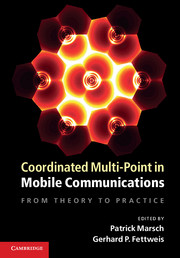Book contents
- Frontmatter
- Contents
- List of Contributors
- Acknowledgements
- List of Abbreviations
- Nomenclature and Notation
- Part I Motivation and Basics
- 1 Introduction
- 2 An Operator's Point of View
- 3 Information-Theoretic Basics
- 4 Gains and Trade-Offs of Multi-Cell Joint Signal Processing
- Part II Practical CoMP Schemes
- Part III Challenges Connected to CoMP
- Part IV Performance Assessment
- Part V Outlook and Conclusions
- References
- Index
3 - Information-Theoretic Basics
from Part I - Motivation and Basics
Published online by Cambridge University Press: 05 August 2012
- Frontmatter
- Contents
- List of Contributors
- Acknowledgements
- List of Abbreviations
- Nomenclature and Notation
- Part I Motivation and Basics
- 1 Introduction
- 2 An Operator's Point of View
- 3 Information-Theoretic Basics
- 4 Gains and Trade-Offs of Multi-Cell Joint Signal Processing
- Part II Practical CoMP Schemes
- Part III Challenges Connected to CoMP
- Part IV Performance Assessment
- Part V Outlook and Conclusions
- References
- Index
Summary
In this chapter, the reader is made familiar with a set of theoretical concepts to analytically capture the variety of CoMP schemes considered in this book. The reader will obtain a first understanding of the general capacity gains expectable from multi-cell joint signal processing, and the many degrees of freedom involved. The chapter introduces notation that will be reused in most parts of the book.
Observed Cellular Scenarios
Throughout the book, we generally consider (subsets of) a large cellular system as depicted in Fig. 3.1. Here, a large number of mobile terminals, or user equipments (UEs), is distributed over a set of cells, where we assume that each cell is served by exactly one BS. As this is the case for most currently deployed cellular systems, we further assume that multiple BSs are grouped into so-called sites. Note that, differing from some other publications, we consider a sector to be equivalent to a cell. The term cluster is used to indicate a set of cells between which some form of CoMP may take place. Note that we assume that each UE in the system aims at transmitting or receiving dedicated information, i.e. multi-cast concepts are not covered in the book. As the number of UEs is typically significantly larger than the number of cells, UEs have to be scheduled to resources, i.e. to certain transmission windows.
- Type
- Chapter
- Information
- Coordinated Multi-Point in Mobile CommunicationsFrom Theory to Practice, pp. 11 - 24Publisher: Cambridge University PressPrint publication year: 2011



